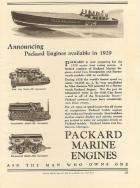|
Edmunds head
|
||||
|---|---|---|---|---|
|
Home away from home
|
Does anyone know what the compression ratio ends up with an Edmunds aluminum head on a 288 engine? My engine is a 1950 Series 23.
Posted on: 2011/3/18 14:13
|
|||
|
Fred Puhn

|
||||
|
||||
|
Re: Edmunds head
|
||||
|---|---|---|---|---|
|
Home away from home
|
My inquiry started with seeing an Edmunds head advertised that it fits a number of different Packard engines. If it does then the compression ration would be different depending on which displacement engine it was bolted on to. I had better be careful when buy an Edmunds head.
Posted on: 2011/3/20 13:11
|
|||
|
Fred Puhn

|
||||
|
||||
|
Re: Edmunds head
|
||||
|---|---|---|---|---|
|
Forum Ambassador

|
If the owner will "cc" a combustion chamber the calculations are pretty straightforward. If you need help with the math, let us know. About 16.3866 cc's per cubic inch.
Posted on: 2011/3/20 13:29
|
|||
|
||||
|
Re: Edmunds head
|
||||
|---|---|---|---|---|
|
Home away from home

|
Quote:
If the compression is too low for you, you can always have the head milled. I believe this is what the factory did, milled the head for the correct compression during manufacture. It's not like there are a lot of aluminum Packard heads out there to choose from. On second thought you would probably be better off to just use the head as is, whatever the ratio. Frankly the difference in power would not be very great anyway. The main thing about an Edmunds head these days is to have one as a rarity.
Posted on: 2011/3/20 14:46
|
|||
|
||||
|
Re: Edmunds head
|
||||
|---|---|---|---|---|
|
Home away from home
|
For gee whizz appeal, an Edmunds head is hard to beat, and being aluminum they will tend to keep the knocking to a minimum. But I really wonder how much they had to offer besides the bump in compression ratio. If you look at the bottom of a Packard head, especially a late one, they have some rather elaborate contours for directing the flow. The plug is over the exhaust valve to ensure that hot area burns first rather than preigniting later before the flame front gets there.
On the Edmunds I have seen, the combustion chamber shape is very simple and the plug is between the valves--quite possibly a better location for very high speed. Anyway, being a horrendous cheapskate, I only ponied up enough to put a 54 288 head on my 51 200 288. Since there were no other significant changes in that engine between 51 and 54 (288s did not get the cam timing change) I have to assume that is where the published 15 hp improvement came from--possibly with a little help from the ad department. In any event, it goes like stink for such a heavy car with such an anchronistic engine. Will someone please bring their Olds 88 by for a race?
Posted on: 2011/3/20 15:30
|
|||
|
||||
|
Re: Edmunds head
|
||||
|---|---|---|---|---|
|
Webmaster
|
Thats interesting Ross. Based on the casing numbers on my head, I have a 1951, 288 AT head on my '54 327 block. Always wondered what the compression ratio is.
Posted on: 2011/3/20 16:04
|
|||
|
-BigKev
1954 Packard Clipper Deluxe Touring Sedan -> Registry | Project Blog 1937 Packard 115-C Convertible Coupe -> Registry | Project Blog |
||||
|
||||
|
Re: Edmunds head
|
||||
|---|---|---|---|---|
|
Home away from home
|
Starting with the definition of compression ratio as volume of the cylinder plus the volume of the head divided by the the volume of the cylinder, a 288 with Ultra and the standard 7.5:1 head should have a head volume of 5.53 cubic inches. Then if we work that backwards using the cylinder volume of a 327 the compression ratio is (40.875+5.53)/5.53= 8.4 to one.
You are probably halfway to the performance of a 359 without the notorious cracking problems.
Posted on: 2011/3/20 19:32
|
|||
|
||||
|
Re: Edmunds head
|
||||
|---|---|---|---|---|
|
Webmaster
|
Wow 8.4 to 1. I would have never though it was that high. Maybe I should pop for the mid-grade 89 octane gas instead of the standard 87 in Calif.
Posted on: 2011/3/20 21:50
|
|||
|
-BigKev
1954 Packard Clipper Deluxe Touring Sedan -> Registry | Project Blog 1937 Packard 115-C Convertible Coupe -> Registry | Project Blog |
||||
|
||||
|
Re: Edmunds head
|
||||
|---|---|---|---|---|
|
Not too shy to talk

|
Quote:
Standard rule for octane to static comp rat is that 87 is good to 9.1 and the 93 is good to almost 10.0 but octane is really more dependent on the timing, cam, the temp. coefficient of the head(s)and valves and so on. An aluminum head will always let you run lower octane for the same static comp rat. On higher mileage engines the main problem for detonation is rough edges that eventually end up as hot spots. There are many other things that come into play as well. An interesting example of extra considerations is my Triumph 750cc bike with 11.1:1 comp rat, proper external oil cooler, aluminum head and pistons: I can run 87 octane until it gets hot out (over 95F) where I then need to run 89 or better. The only thing is that the bottom end of the powerband is weaker than normal.
Posted on: 2011/3/21 11:10
|
|||
|
||||








